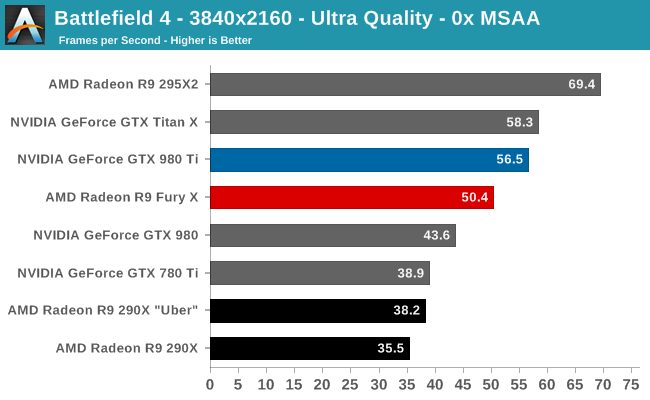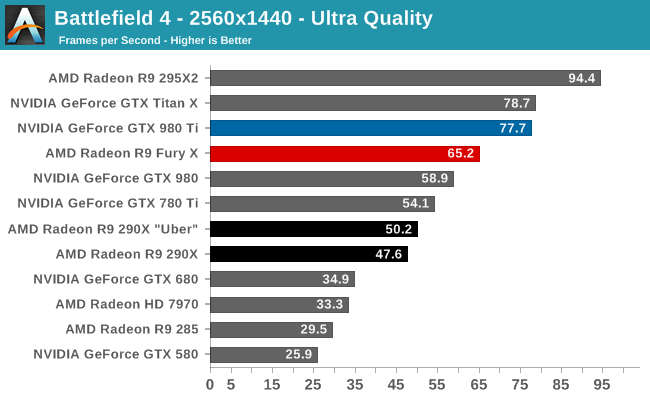The AMD Radeon R9 Fury X Review: Aiming For the Top
by Ryan Smith on July 2, 2015 11:15 AM ESTBattlefield 4
Kicking off our benchmark suite is Battlefield 4, DICE’s 2013 multiplayer military shooter. After a rocky start, Battlefield 4 has since become a challenging game in its own right and a showcase title for low-level graphics APIs. As these benchmarks are from single player mode, based on our experiences our rule of thumb here is that multiplayer framerates will dip to half our single player framerates, which means a card needs to be able to average at least 60fps if it’s to be able to hold up in multiplayer.



As we briefly mentioned in our testing notes, our Battlefield 4 testing has been slightly modified as of this review to accommodate the changes in how AMD is supporting Mantle. This benchmark still defaults to Mantle for GCN 1.0 and GCN 1.1 cards (7970, 290X), but we’re using Direct3D for GCN 1.2 cards like the R9 Fury X. This is due to the lack of Mantle driver optimizations on AMD’s part, and as a result the R9 Fury X sees poorer performance here, especially at 2560x1440 (65.2fps vs. 54.3fps).
In any case, regardless of the renderer you pick, our first test does not go especially well for AMD and the R9 Fury X. The R9 Fury X does not take the lead at any resolution, and in fact this is one of the worse games for the card. At 4K AMD trails by 8-10%, and at 1440p that’s 16%. In fact the latter is closer to the GTX 980 than it is the GTX 980 Ti. Even with the significant performance improvement from the R9 Fury X, it’s not enough to catch up to NVIDIA here.
Meanwhile the performance improvement over the R9 290X “Uber” stands at between 23% and 32% depending on the resolution. AMD not only scales better than NVIDIA with higher resolutions, but R9 Fury X is scaling better than R9 290X as well.










458 Comments
View All Comments
Navvie - Thursday, July 2, 2015 - link
"Which is not say I’m looking" (paragraph 5, first line).Missing a "to" I think.
watzupken - Thursday, July 2, 2015 - link
Brilliant review. Well worth the wait. Thanks Ryan.Taracta - Thursday, July 2, 2015 - link
ROPs, ROPs, ROPs! Hows can they ~ double everything else and keep the same amount of ROPs and expect to win?Thatguy97 - Thursday, July 2, 2015 - link
maybe something to do with cost or yieldtipoo - Thursday, July 2, 2015 - link
They literally hit the size limits interposers can scale up to with this chip - so they can't make it any bigger to pack more transistors for more ROPs, until a die shrink. So they decided on a tradeoff, favouring other things than ROPs.Kevin G - Thursday, July 2, 2015 - link
They had a monster shader count and likely would be fine if they went to 3840 max to make room for more ROPs. 96 or 128 ROPs would have been impressive and really made this chip push lots of pixels. With HBM and the new delta color compression algorithm, there should be enough bandwidth to support these additional ROPs without bottle necking them.AMD also scaled the number of TMUs with the shaders but it likely wouldn't have hurt to have increased them by 50% too. Alternatively AMD could have redesigned the TMUs to have better 16 bit per channel texture support. Either of these changes would have put the texel throughput well beyond the GM200's theoretical throughput. I have a feeling that this is one of the bottlenecks that helps the GM200 pull ahead of Fiji.
tipoo - Friday, July 3, 2015 - link
Not saying it was the best tradeoff - just explaining. They quite literally could not go bigger in this case.testbug00 - Sunday, July 5, 2015 - link
the performances scaling as resolution increase is better than Nvidia, implying the ROPs aren't the bottleneck...chizow - Sunday, July 5, 2015 - link
No, that implies the shaders are the bottleneck at higher resolutions while ROP/fillrate/geometry remained constant. While Nvidia's bottleneck at lower resolutions isn't shader bound but their higher ROP/fillrate allows them to realize this benefit in actual FPS, AMD's ROPs are saturated and simply can't produce more frames.Ryan Smith - Thursday, July 2, 2015 - link
Right now there's not a lot of evidence for R9 Fury X being ROP limited. The performance we're seeing does not have any tell-tale signs of being ROP-bound, only hints here and there that may be the ROPs, or could just as well be the front-end.While Hawaii was due for the update, I'm not so sure we need to jump up in ROPs again so soon.